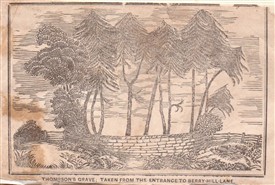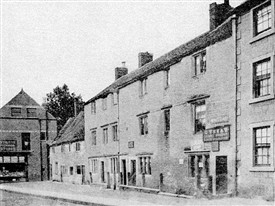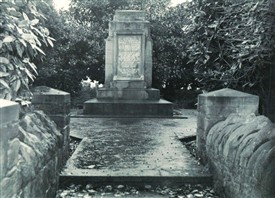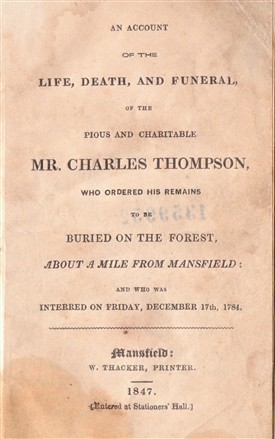Thompson's Grave (or Mound) at Mansfield

Thompson's Mound in 1905

A woodcut from 1847 depicting Thompson's Grave.
From the pamphlet 'The Life, Death and Funeral of... Mr Charles Thompson...' (See title page below)

The House where Mr. Thompson lived and died
From W.H. Groves' "History of Mansfield" (1894)

The monument at Thompson's Mound
Photographed in 1970

Title page from an early published account of the life of Charles Thompson. Written anonymously, it was published in 1847.
A Notts remembrance of the Lisbon earthquake of 1755
"Thompson's Mound" (or 'Thompson's Grave') is located about a mile from the centre of Mansfield on the brow of a hill on the Southwell Road.
Constructed in 1784 upon the death of its founder (and inhabitant), Charles Thompson, it constitutes a local connection with the catastrophe of the Lisbon earthquake of 1755.
Early Life
An account of the early life of Charles Thompson (1714 -1784), a native of Mansfield (1), states that, an only child, he received a good education, which well fitted him for the important appointments he subsequently obtained. At the age of fourteen [in 1728] he had the misfortune to lose his father, Richard Thompson, a maltster, and nine years later he lost his mother.
"After the death of his mother in 1737 he quitted his native town, and after a week's journey he reached London where, after much initial casting around for employment, he finally received an offer from Messrs Richard Chauncey & Co., Russian merchants, to go out as their accredited agent to Persia where to sell cloth for the troops of the Nadir Shah.
W.H. Groves in his "history of Mansfield" takes up the story: "After encountering several severe storms [Thompson's] vessel arrived in safety on the Russian shores. At St.Petersburg Mr. Thompson was detained by order of the Empress Catherine....[eventually granting him] an audience when he gave such an explanation as was satisfactory to her, and was allowed to proceed on his way to Persia...."
He traded in Persia most successfully until the death of Nadir Shah, when troubles in the country rendered it expedient that he should leave it without delay....
"After an absence of ten years he arrived in London in 1750 when he was aged 36 having made during his residence abroad some £4,000 in commission on sales".
Lisbon
Thompson's restless spirit, however, ensured that he did not remain in England for long. He went into partnership with an English cloth merchant trading with Lisbon, at which place he found himself at the time of the great earthquake in 1755 when the city was destroyed.
Thompson survived the disaster, but his house, property and merchandise were flattened. Thompson managed to locate the site of his house, and set workmen to clearing the debris in the hope of perhaps recovering something of his fortune.
Against all the odds, his servant was found alive - if starving - amongst the remains of the house cellar, wherein too (accounts say) Thompson also recovered his strong box containing £7,000. Thereafter, he decided (wisely, we might say) to return to England and pursue a quieter existence, visiting and relieving the poor.
One such benefit to Mansfield was Thompson's School, erected a back street called Toot-hill Lans in Mansfield, for the education of poor boys and girls.
Mansfield Again
In his "In and About Nottinghamshire" (1908 , pp.296-7), Robert Mellors some interesting detail about Thompson's life of retirement in Mansfield. Throughout the seasons he made it his habit to rise early, meditate and pray, tend his garden until 8a.m., read his bible, and if a service was being held at the church he would be found among the congregation
In the afternoons he made a daily pilgrimage to to the spot he had selected for his grave (now 'Thompson's Mound'), and on his way home called upon the poor. At 5pm he took his evening meal, and devoted the remainder of the day to works of charity and devotion (1).
He also located the site of his parents' grave in the churchyard at Mansfield and caused an iron palisade to be contructed around it.
Charles Thompson died on 14th December 1784. "How?", wrote William Howitt (2): "Not in travel - not in sailing over the ocean, nor up tulip-margined rivers of Persia or Arabia Felix; nor yet in an earthquake - but in the dream of one. One night he was heard crying in a voice of horror, 'There! there! - fly! fly! - the town shakes! - the house falls! Ha! the earth opens! - away!' Then the voice ceased.
In the morning it was found that Thompson, re-living the horrors of the Lisbon 'quake, had rolled out of bed between the bedstead and the wall, and there, like a sandbag wedged in a windy crevice, he was dead".
A Singular Funeral and creation of the Mound
In his will Thompson left very specific requirements both for the means of his burial and its subsequent adornment.
"I desire that Edmund Bulbie be employed as undertaker; that he make me a good, strong, plain coffin without ornaments. That I be dressed in a flannel shirt better than two yards long,cap, a slip of flannel around my neck, and in that state put into the coffin, and then to have two yards of plain flannel thrown over me - no shroud snipt or cut.
."I desire that after my funeral as much earth be brought as will raise a mound, and that some trees be planted thereon, and then finish the wall".
"About the coffin, after I am put in, I would have three iron hoops or plates, one towards the head, another about the middle, the third towards the feet, fastened to the coffin, in each of these plates to have an iron ring inserted at the upper part of the coffin for ropes to run through and let me down into the grave, that six or eight poor men be employed as bearers to put me into the hearse and take me out, and that they be allowed five shillings apiece, that George Allen and assistants be employed to make my grave, and if they can make it six yards deep, to be handsomely paid for their trouble, but to make it as deep as they can.
"I would have my internment as private as possible, no bell to toll, the hearse to go down Bath Lane to avoid the town.... I desire that George Allen may be employed to build me a good strong wall, by way of enclosure, seven yards within the sides.
"I desire that after my funeral.... as much earth be brought as will raise a mount, and [that] some trees be planted thereon, and then finish the wall". (Quoted by Groves p.261)
Also by his will there were considerable bequests for the poor to be spent in clothes, and bread and education in day schools, a part of which went to endow Thompson's School, and part to augment Brunt's School.
There was a great funeral led by the vicar and choir chanting, and the trees afterwards planted over the grave have grown great".
The funeral took place on Friday 17th December 1784, but instead of being private, the novelty of the arrangement attracted hundreds of onlookers. The service was conducted by the vicar with the choir proceeding before the hears, chanting as they walked
Why a Mound?
Groves (3) suggests various reasons why the exposed site was chosen by Thompson for his resting place.
Firstly, that when the 'quake at Lisbon took place he was on an eminence in the vicinity of the town similar to the location at Mansfield.
Secondly that during his visits to the parish churchyard at Mansfield he sometimes saw human remains thrown up in the digging of new graves. To avoid disturbing the rest of others when it came to his own interment, therefore, he selected a site far removed from any such possibility.
Bequests from the Will
The sum of £400 to the vicar and churchwardens, the interest to be applied to the purchase of 10 drab coloured coats with white buttons for the clothing of 10 poor men of the town of Mansfield; and 30 yards of baize of the same colour for petticoats for 10 poor elderly women. Any surplus income to de to be distributed amongst the poor in bread.
£600 to Samuel Brunt's charity with a further £600 to the same charity for education of poor children in Mansfield (3) (pp.204-5).
Another account
An anonymous booklet titled "A Visit to Sherwood Forest" (Mansfield: Collinson, 1850 pp13-14) records the Thompson story as follows:-
"This good man has attained considerable celebrity in and near Mansfield, not only by the deeds of mercy with which he adorned the latter part of his chequered and remarkable life, but also from the singularity of directing that his remains should be interred, not in the burial place of his family, but beneath the wild heather of his native forest!
"His reason for so singular an injunction (which was fulfilled) is said to be this.
Being one of the survivors of the disasterous erthquake at Lisbon in 1755, of which he published an account in the Gentleman's Magazine of that date, he was on his return home so struck with the similarity of the situation and prospect to that of the hill where he had escaped after the sudden earthquake, and from which he witnessed the succeeding awful fire, and the destruction of much of his own property, that by a whimsical fancy he resolved to be here buried.....
The prospect from this plot is extremely beautiful and varied; with a background of noble oaks, on the right hand and before you the wide expanse of forest with its changing carpet of brown or purple heath and golden crested gorse stretches itself for miles at the feet, bordered in the distance by the more highly cultivated rising ground which is still surmounted by the distant hills of Yorkshire and... Lincolnshire..."
Notes
(1) ANDREWS, William pp.138-142 of Old Nottinghamshire, J. Potter Briscoe ed., 1881.
(2) HOWITT, William
(3) GROVES, William Horner The History of Mansfield (Nottingham: Frank Murray, 1894)